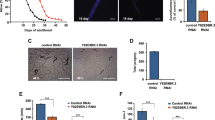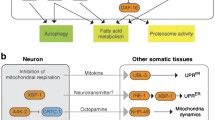Abstract
Objective
To identify new genes required for neurosecretory control of aging in C. elegans.
Methods
In view of the importance of nervous system in aging regulation, we performed the screen for genes involved in the aging regulation from genetic loci encoding synaptic proteins by lifespan assay and accumulation of lipofuscin autofluorescence. We further investigated the dauer formation phenotypes of their corresponding mutants and whether they were possibly up-regulated by the insulin-like signaling pathway.
Results
The genetic loci of unc-10, syd-2, hlb-1, dlk-1, mkk-4, scd-2, snb-1, ric-4, nrx-1, unc-13, sbt-1 and unc-64 might be involved in the aging control. In addition, functions of unc-10, syd-2, hlb-1, dlk-1, mkk-4, scd-2, snb-1, ric-4 and nrx-1 in regulating aging may be opposite to those of unc-13, sbt-1 and unc-64. The intestinal autofluorescence assay further indicated that the identified long-lived and short-lived mutants were actually due to the suppressed or accelerated aging. Among the identified genes, syd-2, hlb-1, mkk-4, scd-2, snb-1, ric-4 and unc-64 were also involved in the control of dauer formation. Moreover, daf-2 mutation positively regulated the expression of syd-2 and hlb-1, and negatively regulated the expression of mkk-4, nrx-1, ric-4, sbt-1, rpm-1, unc-10, dlk-1 and unc-13. The daf-16 mutation positively regulated the expression of syd-2 and hlb-1, and negatively regulated the expression of mkk-4, nrx-1, sbt-1, rpm-1, unc-10, dlk-1 and unc-13.
Conclusion
These data suggest the possibly important status of the synaptic transmission to the animal’s life-span control machinery, as well as the dauer formation control.
摘要
目的
鉴定参与线虫衰老的神经内分泌调控的新基因。
方法
鉴于神经系统在衰老调控中的重要作用, 通过寿命分析和脂褐质自发荧 光的检测, 从编码突触蛋白的遗传位点中选参与衰老调控的基因。 我们还进一步检查了这些遗传位点相应的突变体的永久性幼虫形成情况, 探讨它们是否可能受胰岛素样信号通路的调控。
结果
遗传位点 unc-10, syd-2, hlb-1, dlk-1, mkk-4, scd-2, snb-1, ric-4, nrx-1, unc-13, sbt-1, unc-64 可能参与线虫衰老的调控。 而且在衰老的调控中, unc-10, syd-2, hlb-1, dlk-1, mkk-4, scd-2, snb-1, ric-4, nrx-1 的功能可能与 unc-13, sbt-1, unc-64 相反。 肠道脂褐质自发荧光的检测进一步证明了选出的各基因对应突变体的长寿或短寿表型, 是由减慢或缩短的组织衰老所致。 在选出的基因中, syd-2, hlb-1, mkk-4, scd-2, snb-1, ric-4, unc-64 也参与了永久性幼虫形成的调控。 另外, daf-2 突变增强了 syd-2 和 hlb-1 的表达, 降低了 mkk-4, nrx-1, ric-4, sbt-1, rpm-1, unc-10, dlk-1, unc-13 的表达。 daf-16 突变提高了 syd-2 和 hlb-1 的表达, 降低了 mkk-4, nrx-1, sbt-1, rpm-1, unc-10, dlk-1, unc-13 的表达。
结论
突触功能可能在个体寿命和永久性幼虫形成的调控机制中具有重要的作用。
Similar content being viewed by others
References
Garigan D, Hsu A, Fraser AG, Kamath RS, Ahringer J, Kenyon C. Genetic analysis of tissue aging in Caenorhabditis elegans: A role for heat-shock factor and bacterial proliferation. Genetics 2002, 161: 1101–1112.
Kenyon C, Chang J, Gensch E, Rudner A, Tabtiang R. A C. elegans mutant that lives twice as long as wild type. Nature 1993, 366: 461–464.
Morris JZ, Tissenbaum HA, Ruvkun G. A phosphatidylinositol-3-OH kinase family member regulating longevity and diapause in Caenorhabditis elegans. Nature 1996, 382: 536–539.
Ogg S, Paradis S, Gottlieb S, Patterson GI, Lee L, Tissenbaum HA, et al. The Folk head transcription factor DAF-16 transduces insulin-like metabolic and longevity signals in C. elegans. Nature 1997, 389: 994–999.
Murphy CT, McCarroll SA, Bargmann CI, Fraser A, Kamath RS, Ahringer J, et al. Genes that act downstream of DAF-16 to influence the lifespan of Caenorhabditis elegans. Nature 2003, 424: 277–283.
Lin K, Hsin H, Libina N, Kenyon C. Regulation of the Caenorhabditis elegans longevity protein DAF-16 by insulin/IGF-1 and germling signaling. Nature Genetics 2001, 28: 139–145.
Tissenbaum HA, Guarente L. Increased dosage of a sir-2 gene extends lifespan in Caenorhabditis elegans. Nature 2001, 410: 227–230.
Libina N, Berman JR, Kenyon C. Tissue-specific activities of C. elegans DAF-16 in the regulation of lifespan. Cell 2003, 115: 489–502.
Ailion M, Inoue T, Weaver CI, Holdcraft RW, Thomas JH. Neurosecretory control of aging in Caenorhabditis elegans. Proc Natl Acad Sci USA 1999, 96: 7394–7397.
Berman JR, Kenyon C. Germ-cell loss extends C. elegans life span through regulation of DAF-16 by kri-1 and lipophilichormone signaling. Cell 2006, 124: 1055–1068.
Koushika SP, Richmond JE, Hadwiger G, Weimer RM, Jorgensen EM, Nonet Ml. A post-docking role for active zone protein Rim. Nat Neurosci 2001, 4: 997–1005.
Madison JM, Nurrish S, Kaplan JM. UNC-13 interaction with syntaxin is required for synaptic transmission. Curr Biol 2005, 15: 2236–2242.
Zhen M, Jin Y. The liprin protein SYD-2 regulates the differentiation of presynaptic termini in C. elegans. Nature 1999, 401: 371–375.
Nakata K, Abrams B, Grill B, Goncharov A, Huang X, Chisholm AD, et al. Regulation of a DLK-1 and p38 MAP kinase pathway by the ubiquitin ligase RPM-1 is required for presynaptic development. Cell 2005, 120: 407–420.
Liao EH, Hung W, Abrams B, Zhen M. An SCF-like ubiquitin ligase complex that controls presynaptic differentiation. Nature 2004, 430: 345–350.
Nonet ML, Saifee O, Zhao H, Rand JB, Wei L. Synaptic transmission deficits in Caenorhabditis elegans synaptobrevin mutants. J Neurosci 1998, 18: 70–80.
Jorgensen EM, Hartwieg E, Schuske K, Nonet ML, Jin Y, Horvitz HR. Defective recycling of synaptic vesicles in synaptotagmin mutants of Caenorhabditis elegans. Nature 1995, 378: 196–199.
Ogawa H, Harada S, Sassa T, Yamamoto H, Hosono R. Functional properties of the unc-64 gene encoding a Caenorhabditis elegans syntaxin. J Biol Chem 1998, 273: 2192–2198.
Sassa T, Harada S, Ogawa H, Rand JB, Maruyama IN, Hosono R. Regulation of the UNC-18-Caenorhabditis elegans syntaxin complex by UNC-13. J Neurosci 1999, 19: 4772–4777.
Weimer RM, Richmond JE, Davis WS, Hadwiger G, Nonet ML, Jorgensen EM. Defects in synaptic vesicle docking in unc-18 mutants. Nat Neurosci 2003, 6: 1023–1030.
Nam CI, Chen L. Postsynaptic assembly induced by neurexin-neuroligin interaction and neurotransmitter. Proc Natl Acad Sci USA 2005, 102: 6137–6142.
Sieburth D, Ch’ng Q, Dybbs M, Tavazoie M, Kennedy S, Wang D, et al. Systematic analysis of genes required for synapse structure and function. Nature 2005, 436: 510–517.
Brenner S. The genetics of Caenorhabditis elegans. Genetics 1974, 77: 71–94.
Boehm M, Slack F. A developmental timing microRNA and its target regulate life span in C. elegans. Science 2005, 310: 1954–1957.
Inoue T, Thomas JH. Suppressors of transforming growth factor-β pathway mutants in the Caenorhabditis elegans dauer formation pathway. Genetics 2000, 156: 1035–1046.
Morse DP, Bass BL. Long RNA hairpins that contain inosine are present in Caenorhabditis elegans poly(A)+ RNA. Proc Natl Acad Sci USA 1999, 96: 6048–6053.
Shen LL, Wang DY. Differentiation and function of presynaptic active zone. Neurosci Bull 2005, 21: 335–343.
Dorman JB, Albinder B, Shroyer T, Kenyon C. The age-1 and daf-2 genes function in a common pathway to control the lifespan of Caenorhabditis elegans. Genetics 1995, 141: 1399–1406.
Wang DY, Wang Y. Screening for genetic loci affecting the active zone formation in C. elegans. Neurosci Bull 2006, 22: 301–304.
Sollner T, Bennett MK, Whiteheart SW, Scheller RH, Rothman JE. A protein assembly-disassembly pathway in vitro that may correspond to sequential steps of synaptic vesicle docking, activation, and fusion. Cell 1993, 75: 409–418.
Apfeld J, Kenyon C. Regulation of lifespan by sensory perception in Caenorhabditis elegans. Nature 1999, 402: 804–809.
Author information
Authors and Affiliations
Corresponding author
Rights and permissions
About this article
Cite this article
Shen, LL., Wang, Y. & Wang, DY. Involvement of genes required for synaptic function in aging control in C. elegans . Neurosci. Bull. 23, 21–29 (2007). https://doi.org/10.1007/s12264-007-0003-4
Received:
Published:
Issue Date:
DOI: https://doi.org/10.1007/s12264-007-0003-4




